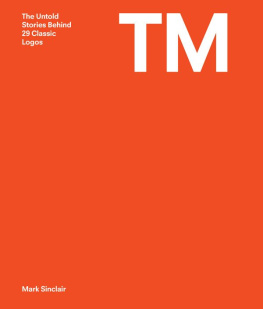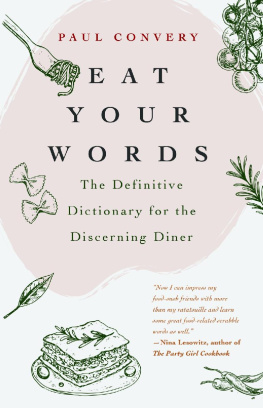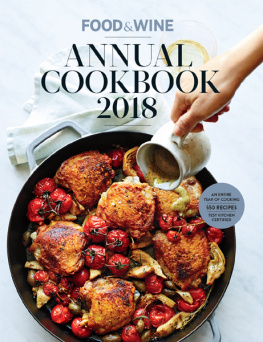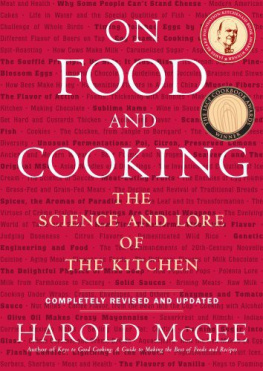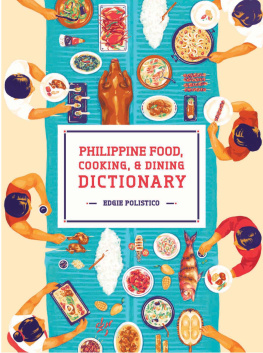Dictionary of
Food
International Food and Cooking
Terms from A to Z
Second Edition
Charles Sinclair
A & C Black London
Contributors
Alyson Cole, Eri Eguchi, Magda Hughes, Sarah Lusznat, Diane Nicholls, Helen Szirtes, Maureen Teulier
First published in Great Britain 1998 as International Dictionary of Food and Cooking. Reprinted 1999
Second edition published 2004 as A Cooks Dictionary
Paperback edition published 2005 as Dictionary of Food
This electronic edition published 2010 by A&C Black Publishers Ltd
A&C Black Publishers Ltd, 36 Soho Square, London W1D 3QY
www.acblack.com
Copyright Charles Sinclair, 1998
The right of Charles Sinclair to be identified as the author of this work has been asserted by him in accordance with the Copyright, Designs and Patents Act 1988.
All rights reserved. You may not copy, distribute, transmit, reproduce or otherwise make available this publication (or any part of it) in any form, or by any means (including without limitation electronic, digital, optical, mechanical, photocopying, printing, recording or otherwise), without the prior written permission of the publisher. Any person who does any unauthorised act in relation to this publication may be liable to criminal prosecution and civil claims for damages.
No responsibility for loss caused to any individual or organisation acting or refraining from action as a result of the material in this publication can be accepted by A & C Black Publishers Ltd or the authors.
A CIP catalogue record for this book is available from the British Library
Print ISBN: 9-780-7136-7500-9
Electronic ISBN: 9-781-4081-0218-3
Visit www.acblack.com to find out more about our authors and their books.
You will find extracts, authors interviews, author events and you can sign up for newsletters to be the first to hear about our latest releases and special offers.
The language of English cuisine is unusual in that it uses many words of foreign origin, often in their original spelling. The purpose of this dictionary is to give short definitions of these words so that both the practising chef and the amateur enthusiast, the gastronome and the student may quickly determine the meaning. It is not a recipe book or a repertoire, but it does give the ingredients of classic and well-known dishes, together with a brief summary of the cooking processes. A picture of a chef's hat indicates dishes that the professional or amateur cook could, after a little experimentation, roughly reproduce.
As in all dictionaries, the compiler has had to be selective in the words chosen for inclusion. Even so, the dictionary lists over 24,000 words, of which very few are not in current use somewhere in the English-speaking world. Some entries have been included for historical reasons and the browser will find much of interest. Classic dishes, ingredients, cooking processes, cooking implements and equipment, descriptions of function and details of service are included as well as scientific, botanical, medical, technological, hygienic and nutritional terms. Many single words appertaining to the catering industry from the countries of the European Union are translated, and the dictionary is of use in translating menu items not included. Drinks, wines and spirits are not included except where they are used as flavourings in food and food preparation.
Order of entries
All words are listed in strict alphabetical order, ignoring spaces or hyphens. Thus point comes after apog and S-Gebck after sformata. Numbers come before letters, so E-numbers such as E101 and E483 come before earth almond and earth nut. Accented characters are assumed to follow the unaccented characters which they resemble. Thus comes before or , for example.
Verbs are listed as blent, to and roast, to, for example.
The names of many items in the French repertoire have been taken over wholesale into the English language. For example, sauce bchamel is known as bchamel sauce, often retaining the French acute accent, and for this reason and to avoid making the entries too repetitious this type of entry is listed in reverse order of the words in the dictionary. Thus sauce bchamel would appear under the heading bchamel sauce; other examples are supreme, sauce and aurora, sauce. Similar examples occur with whole classes of French names such as beurre (butter), (garnish), salade, potage (soup), consomm, souffl etc. Phrases from French and other European languages beginning with la, al, alla, en, etc. are also listed in reverse order:
diableFrance 1. An unglazed earthenware cooking pot in two symmetrical halves which when put together resembles a ball with two flat sides and a long handle. Used for cooking chestnuts and vegetables without water either in the oven or on top of the stove. Can be shaken and turned over for even cooking. 2. Kidneys or poussins, split, flattened, grilled and served with sauce diable
diable, laFrance Strongly flavoured with a selection of Worcestershire and Tabasco sauces, mustard, cayenne pepper and vinegar. Also called devilled
diable, sauceEngland, France A reduction of chopped shallots, white wine, vinegar, cayenne pepper and mignonette pepper simmered with demi-glace, strained and seasoned. Served with fried or grilled fish or meat. Also called devilled sauce
diable de merFrance seemonkish
diablo, enMexico, Spain Devilled, hot and spicy
diablotinsFrance 1. Cheese-flavoured crotons 2. Christmas crackers
Regional and national dishes
The country or region of origin of words or phrases, if important or not obvious from the definition, is given immediately after the entry. Where a dish is of some regional origin within a country, the region will usually be indicated in the text, whereas the name of the country will be given after the entry:
figgy pastryEngland A shortcrust pastry incorporating an amount of dried vine fruits equal in weight to the fat, often used for meat or bird pies ( NOTE: Figgy is the West Country term for dried vine fruits)
Similarly, where a country is contained within a larger grouping such as Central Europe or West Africa, the text will indicate the country of origin. This style is only used where there are relatively few entries for the country. An exception is made for the original four kingdoms which made up the British Isles: these are treated as separate countries, i.e. England, Scotland, Wales and Ireland.
Terms from French and other cuisines which are also used in English cookery are labelled England, France, for example.
Recipes
In some of the entries, outline recipes are given together with quantities of key ingredients. The usual method of giving quantities is to give the relative proportions by weight in brackets after the list of ingredients. Thus for example genoise paste is defined as Flour, butter, caster sugar and eggs (2:1:3:5) made up This could be 4 oz of flour, 2 oz of butter, 6 oz of caster sugar and 5 eggs (recalling that a standard egg weighs 2 oz or 60g), or alternatively in metric measure, 24g of flour, 12g of butter and 36g of caster sugar to each egg.
All cooking temperatures are given in C (degrees centigrade or Celsius). Equivalents in other units (F or gas mark) can be found in any reasonable recipe book.
Transliteration
The transliterations used from the Greek, Russian, Southeast Asian, Chinese, etc. languages are those adopted in the English translations of the original dishes and terms. Different authorities give different transliterations and, where several are in common use for the same dish, they are all given in their correct alphabetical order, referring back or forwards to the main entry. Chinese terms are transliterated in a variety of ways from either Cantonese or Mandarin according to the source of the entry. Accents indicating tones are not shown for Chinese transliterations, hence they give only a very rough approximation of the spoken word.






